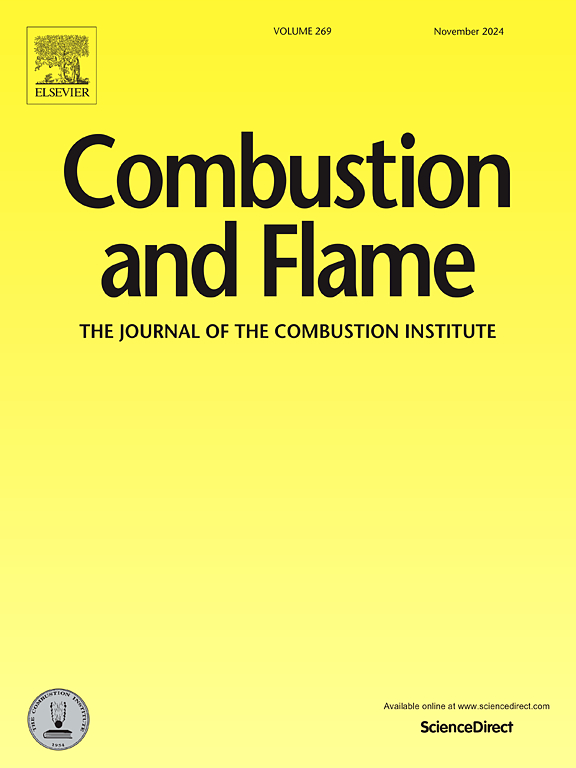An experimental speciation study of DME, OME1, and OME2 in a single-pulse shock tube at high pressures
IF 5.8
2区 工程技术
Q2 ENERGY & FUELS
引用次数: 0
Abstract
The pyrolysis of dimethyl ether (DME), oxymethylene ether-1 (OME1), and oxymethylene ether-2 (OME2) and their oxidation with oxygen under three different equivalence ratios (φ = 0.5, 1.0, and 2.0) have been studied experimentally in a customized single-pulse shock tube. The measurements were carried out highly diluted in argon over a wide temperature range between 975 K and 1400 K at initial pressures behind reflected shock waves p5(t = 0) of about 16 bar. The classical single-pulse mode involving a dump tank was not employed. Instead, post-shock gas samples were extracted through a fast-acting solenoid valve located inside the end flange of the driven section of the shock tube, to reduce measurement errors from thermal boundary layers. Thirteen stable species were identified and quantified by three different gas chromatographs simultaneously, in detail, DME, OME1, OME2, methane, ethane, ethene, acetylene, carbon monoxide, carbon dioxide, molecular hydrogen, formaldehyde, methanol, and methyl formate. The temperature dependent, measured, and normalized species concentration profiles were compared with the predicted species profiles obtained by using two different chemical kinetic reaction mechanisms from the literature and an updated version of the in-house reaction model DLR Concise. In addition, speciation data of 1,1,1-trifluoroethane and nitrous oxide at elevated pressures are presented, which were used as external chemical thermometers to validate the calculated temperature behind the reflected shock wave of the single-pulse shock tube.
Novelty and Significance
In this work, a series of more than 300 single-pulse shock tube experiments have been performed, to investigate the decomposition products of oxygenated fuels at pressures around 16 bar. To the best of our knowledge, no speciation data is yet available for this pressure regime. By comparing the data with chemical-kinetic reaction mechanisms from the literature, opportunities for model improvement have been identified, particularly regarding methanol formation, which could be further developed in the future.
The presented high-pressure validation data contributes to the development of chemical-kinetic reaction models for new oxygenated fuels derived from renewable sources. By incorporating these reaction mechanisms into CFD codes, advancements in combustors and engine technology are facilitated, promoting cleaner combustion processes.
求助全文
约1分钟内获得全文
求助全文
来源期刊

Combustion and Flame
工程技术-工程:化工
CiteScore
9.50
自引率
20.50%
发文量
631
审稿时长
3.8 months
期刊介绍:
The mission of the journal is to publish high quality work from experimental, theoretical, and computational investigations on the fundamentals of combustion phenomena and closely allied matters. While submissions in all pertinent areas are welcomed, past and recent focus of the journal has been on:
Development and validation of reaction kinetics, reduction of reaction mechanisms and modeling of combustion systems, including:
Conventional, alternative and surrogate fuels;
Pollutants;
Particulate and aerosol formation and abatement;
Heterogeneous processes.
Experimental, theoretical, and computational studies of laminar and turbulent combustion phenomena, including:
Premixed and non-premixed flames;
Ignition and extinction phenomena;
Flame propagation;
Flame structure;
Instabilities and swirl;
Flame spread;
Multi-phase reactants.
Advances in diagnostic and computational methods in combustion, including:
Measurement and simulation of scalar and vector properties;
Novel techniques;
State-of-the art applications.
Fundamental investigations of combustion technologies and systems, including:
Internal combustion engines;
Gas turbines;
Small- and large-scale stationary combustion and power generation;
Catalytic combustion;
Combustion synthesis;
Combustion under extreme conditions;
New concepts.
 求助内容:
求助内容: 应助结果提醒方式:
应助结果提醒方式:


